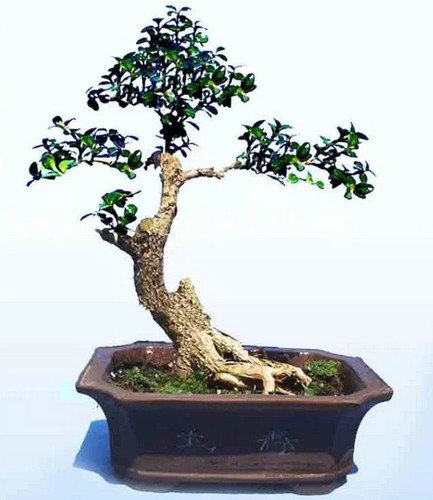The method of making firethorn bonsai
The best soil for firethorn bonsai is the fatter garden soil or the surface soil in the mountain forest, and the mature base fertilizer, fine sand and cultivated soil can also be used. The firethorn had better turn the basin once a year. Turn the basin to choose late autumn or early spring, that is, after stopping the growth of new shoots or before they begin to grow. For the fire thorn without hanging fruit, the pot can be changed all the year round. No matter when you change the soil, you should stay in the soil, cut off the long roots, do not nest the roots, and install the basin quickly so as not to affect the growth.
1. Cutting time:
Firethorn basin is very fastidious, in order to set off its red fruit, generally use white, light blue, light green or light yellow and other light color, cold bonsai basin. Hippophae rhamnoides likes to be wet and fat, and likes a climate with sufficient light, good ventilation and warm and humid climate. Pyracantha is resistant to barren, and the temperature can be as low as 0 ℃-5 ℃ or less. Hippophae rhamnoides has developed root system, fast branching, rapid growth, resistance to pruning and flat binding.
September is the best. Some people think that cutting in spring is better in mildew and rainy season. According to our observation, in July and August every year, Hippophae rhamnoides differentiates into flower buds in the coming year, and most of them complete the process of flower bud differentiation in September. At this time, the seedlings obtained by cutting will bloom in the following year. In addition, the weather is getting cooler in September, and the ground temperature is still high, at this time the cuttage is not in danger of cutting rot, but suitable for the habit of Hippophae rhamnoides, the survival rate can reach 100%.
Second, the cutting process:
1. Cuttings: the sturdy branches of the current year are selected and cut into sections of 10ml 15cm long. Two pairs of leaves are left in the upper part, and the lower leaves can be removed.
2. Matrix: River sand or loose permeable culture soil. River sand can be washed and disinfected with boiled water, cultured soil can be disinfected with formalin 50 times solution, or disinfected by sunlight exposure.
3. Cuttage: there are two methods: you can first cut in the river sand, keep it moist every day, slightly shade, take root after about 1 month, and then transplant it in a nutrition bowl with culture soil and put it in a cold room to survive the winter; it can also be directly planted in the culture soil, one bowl and one seedling, under the condition of 20 ℃ and 25 min, rooting for 30 days.
Third, styling:
Firethorn bonsai should adopt the modeling method of coarse binding and fine cutting, which is generally carried out in autumn. first, the trunk is roughly tied into different forms such as oblique stem or lying dry with iron wire or brown wire, and then it is cultivated for a period of time, and then the pile landscape layer is trimmed and shaped according to the design, so that the whole tree shape is clear and elegant.
After the cuttage survived, the cuttings were planted in March of the following year, and more humus soil and organic fertilizer could be added to the culture soil to make it germinate and grow luxuriantly as soon as possible. After flowering in May, you can change 4-inch pots for maintenance, and provide sufficient water and fertilizer to make the branches fully lengthened and thickened. It can be modeled at the end of August and the beginning of September.
Time: 2019-05-26 Click:
- Prev

The method of making bonsai of Guazi and Huangyang
Guazihuang poplar, also known as Buxus tomentosa, thousand-year-old dwarf, etc., is an evergreen shrub or small tree of the family Populus, which is native to the Yangtze River Basin and the south of central China. Sexual preference for warm, semi-overcast, humid climate, drought, cold and pruning resistance, is a shallow root tree species, slow growth, long life, is an excellent wood for bonsai production
- Next

Making micro-ecological bonsai
In a transparent glass vase, or ceramic vase, iron vase, planted with ferns, succulent plants, with sand, stone, wood, moss, plus all kinds of lovely ornaments to create a warm scene, one by one beautiful and fresh ecological micro-landscape unfolded in front of us. Get in touch with nature with your heart
Related
- Fuxing push coffee new agricultural production and marketing class: lack of small-scale processing plants
- Jujube rice field leisure farm deep ploughing Yilan for five years to create a space for organic food and play
- Nongyu Farm-A trial of organic papaya for brave women with advanced technology
- Four points for attention in the prevention and control of diseases and insect pests of edible fungi
- How to add nutrient solution to Edible Fungi
- Is there any good way to control edible fungus mites?
- Open Inoculation Technology of Edible Fungi
- Is there any clever way to use fertilizer for edible fungus in winter?
- What agents are used to kill the pathogens of edible fungi in the mushroom shed?
- Rapid drying of Edible Fungi

